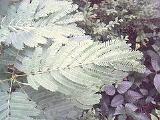
Desmanthus
Encyclopedia
Desmanthus is a genus of flowering plant
s in the subfamily Mimosoideae
of the pea
family, Fabaceae
. It contains about 24 species of herbs
and shrub
s that are sometimes described as being suffruiticose and have bipinnate
leaves. Desmanthus is closely related to Leucaena
and in appearance is similar to Neptunia
. Like Mimosa
and Neptunia, Desmanthus species fold their leaves
in the evening. They are native to Mexico
and North
, Central
and South America
.

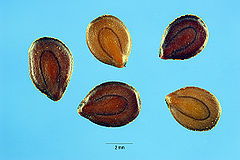
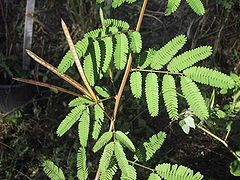
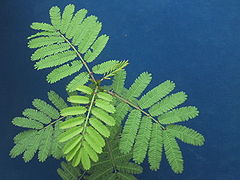
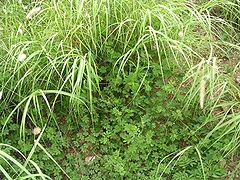
D. virgatus has a number of common names such as `hedge lucerne' in India, `little mimosa' in Brazil, `bundleflower' in the USA, `leucaena mini' in Indonesia, `dwarf koa', `dais' in Mexico,`donkey bean' and `desmanthus'.
The term "donkey bean" comes from Central America where Desmanthus is highly regarded as a fodder
for donkey
s which are valued domestic draught animals.
There are considerable differences in the descriptions of Desmanthus in the literature (see Bogdan 1977; Skerman 1977; National Academy of Science 1979; Allen & Allen 1981; Reid 1983; Hacker 1990). For example, Reid (1983) says that Desmanthus virgatus ranges from "leggy" plants in the humid tropics to compact bushes in the semi-arid zones to prostrate in the montane zones; Allen and Allen (1981) state that Desmanthus grows to 3 metres; Hacker (1990) states that D. virgatus is an erect shrub 1.3 metres tall. All these views illustrate the great diversity and polymorphism within the genus and between species.
In the United States, Illinois bundleflower (Desmanthus illinoensis
) is the most widely distributed Desmanthus species. The root-bark, which accounts for half of the total weight of the root system, is reported to contain anywhere from 0% to 0.34% DMT
and 0.11% N-Methyltryptamine
. Alkaloid
content is highly variable in this species.
Likewise, root bark of Desmanthus leptolobus
has been found to contain N,N-DMT and related tryptamines. While its only reported quantitative analysis was 0.14% (Appleseed), all instances of co-occurrence with D. illinoensis showed it to be noticeably stronger than D. illinoensis, according to co-thin layer chromatography
of the root bark.
three species of Desmanthus have been released as a pasture
legume and many other accessions are being evaluated as pasture species for clay soils. The three released cultivar
s are:
Flowering plant
The flowering plants , also known as Angiospermae or Magnoliophyta, are the most diverse group of land plants. Angiosperms are seed-producing plants like the gymnosperms and can be distinguished from the gymnosperms by a series of synapomorphies...
s in the subfamily Mimosoideae
Mimosoideae
Mimosoideae is a subfamily of the flowering plant family Fabaceae characterized by flowers with small petals and numerous prominent stamens...
of the pea
Pea
A pea is most commonly the small spherical seed or the seed-pod of the pod fruit Pisum sativum. Each pod contains several peas. Peapods are botanically a fruit, since they contain seeds developed from the ovary of a flower. However, peas are considered to be a vegetable in cooking...
family, Fabaceae
Fabaceae
The Fabaceae or Leguminosae, commonly known as the legume, pea, or bean family, is a large and economically important family of flowering plants. The group is the third largest land plant family, behind only the Orchidaceae and Asteraceae, with 730 genera and over 19,400 species...
. It contains about 24 species of herbs
Herbaceous plant
A herbaceous plant is a plant that has leaves and stems that die down at the end of the growing season to the soil level. They have no persistent woody stem above ground...
and shrub
Shrub
A shrub or bush is distinguished from a tree by its multiple stems and shorter height, usually under 5–6 m tall. A large number of plants may become either shrubs or trees, depending on the growing conditions they experience...
s that are sometimes described as being suffruiticose and have bipinnate
Pinnate
Pinnate is a term used to describe feather-like or multi-divided features arising from both sides of a common axis in plant or animal structures, and comes from the Latin word pinna meaning "feather", "wing", or "fin". A similar term is pectinate, which refers to a comb-like arrangement of parts...
leaves. Desmanthus is closely related to Leucaena
Leucaena
Leucaena is a genus of flowering plants in the subfamily Mimosoideae of the legume family Fabaceae. It contains about 24 species of trees and shrubs, which are commonly known as Leadtrees. They are native to the Americas, ranging from Texas in the United States south to Peru...
and in appearance is similar to Neptunia
Neptunia
Neptunia may refer to:* Neptunia , a genus of plants within the subfamily Mimoseae* Neptunia, a cartoon character in the television series Darkwing Duck, see list of Darkwing Duck characters, an Italian coaster...
. Like Mimosa
Mimosa
Mimosa is a genus of about 400 species of herbs and shrubs, in the subfamily Mimosoideae of the legume family Fabaceae. The generic name is derived from the Greek word μιμος , meaning "mimic."...
and Neptunia, Desmanthus species fold their leaves
Rapid plant movement
Rapid plant movement encompasses movement in plant structures occurring over a very short period of time, usually under one second. For example, the Venus Flytrap closes its trap in about 100 milliseconds. The Dogwood Bunchberry's flower opens its petals and fires pollen in less than 0.5 milliseconds...
in the evening. They are native to Mexico
Mexico
The United Mexican States , commonly known as Mexico , is a federal constitutional republic in North America. It is bordered on the north by the United States; on the south and west by the Pacific Ocean; on the southeast by Guatemala, Belize, and the Caribbean Sea; and on the east by the Gulf of...
and North
North America
North America is a continent wholly within the Northern Hemisphere and almost wholly within the Western Hemisphere. It is also considered a northern subcontinent of the Americas...
, Central
Central America
Central America is the central geographic region of the Americas. It is the southernmost, isthmian portion of the North American continent, which connects with South America on the southeast. When considered part of the unified continental model, it is considered a subcontinent...
and South America
South America
South America is a continent situated in the Western Hemisphere, mostly in the Southern Hemisphere, with a relatively small portion in the Northern Hemisphere. The continent is also considered a subcontinent of the Americas. It is bordered on the west by the Pacific Ocean and on the north and east...
.
Description





D. virgatus has a number of common names such as `hedge lucerne' in India, `little mimosa' in Brazil, `bundleflower' in the USA, `leucaena mini' in Indonesia, `dwarf koa', `dais' in Mexico,`donkey bean' and `desmanthus'.
The term "donkey bean" comes from Central America where Desmanthus is highly regarded as a fodder
Fodder
Fodder or animal feed is any agricultural foodstuff used specifically to feed domesticated livestock such as cattle, goats, sheep, horses, chickens and pigs. Most animal feed is from plants but some is of animal origin...
for donkey
Donkey
The donkey or ass, Equus africanus asinus, is a domesticated member of the Equidae or horse family. The wild ancestor of the donkey is the African Wild Ass, E...
s which are valued domestic draught animals.
There are considerable differences in the descriptions of Desmanthus in the literature (see Bogdan 1977; Skerman 1977; National Academy of Science 1979; Allen & Allen 1981; Reid 1983; Hacker 1990). For example, Reid (1983) says that Desmanthus virgatus ranges from "leggy" plants in the humid tropics to compact bushes in the semi-arid zones to prostrate in the montane zones; Allen and Allen (1981) state that Desmanthus grows to 3 metres; Hacker (1990) states that D. virgatus is an erect shrub 1.3 metres tall. All these views illustrate the great diversity and polymorphism within the genus and between species.
In the United States, Illinois bundleflower (Desmanthus illinoensis
Desmanthus illinoensis
Desmanthus illinoensis is a plant in many areas of the south central US.Root bark of D...
) is the most widely distributed Desmanthus species. The root-bark, which accounts for half of the total weight of the root system, is reported to contain anywhere from 0% to 0.34% DMT
Dimethyltryptamine
N,N-Dimethyltryptamine is a naturally occurring psychedelic compound of the tryptamine family. DMT is found in several plants, and also in trace amounts in humans and other mammals, where it is originally derived from the essential amino acid tryptophan, and ultimately produced by the enzyme INMT...
and 0.11% N-Methyltryptamine
N-Methyltryptamine
N-Methyltryptamine , or methyltryptamine, is a member of the tryptamine chemical class. It is an alkaloid, probably derived from L-tryptophan, that has been found in the bark, shoots and leaves of several plant species, including Virola, Acacia, Mimosa and Desmanthus often together with the...
. Alkaloid
Alkaloid
Alkaloids are a group of naturally occurring chemical compounds that contain mostly basic nitrogen atoms. This group also includes some related compounds with neutral and even weakly acidic properties. Also some synthetic compounds of similar structure are attributed to alkaloids...
content is highly variable in this species.
Likewise, root bark of Desmanthus leptolobus
Desmanthus leptolobus
Desmanthus leptolobus is an inconspicuous and more or less prostrate plant of the genus Desmanthus. It can be found growing wild in many areas of the south central US...
has been found to contain N,N-DMT and related tryptamines. While its only reported quantitative analysis was 0.14% (Appleseed), all instances of co-occurrence with D. illinoensis showed it to be noticeably stronger than D. illinoensis, according to co-thin layer chromatography
Thin layer chromatography
Thin layer chromatography is a chromatography technique used to separate mixtures. Thin layer chromatography is performed on a sheet of glass, plastic, or aluminum foil, which is coated with a thin layer of adsorbent material, usually silica gel, aluminium oxide, or cellulose...
of the root bark.
Uses
In AustraliaAustralia
Australia , officially the Commonwealth of Australia, is a country in the Southern Hemisphere comprising the mainland of the Australian continent, the island of Tasmania, and numerous smaller islands in the Indian and Pacific Oceans. It is the world's sixth-largest country by total area...
three species of Desmanthus have been released as a pasture
Pasture
Pasture is land used for grazing. Pasture lands in the narrow sense are enclosed tracts of farmland, grazed by domesticated livestock, such as horses, cattle, sheep or swine. The vegetation of tended pasture, forage, consists mainly of grasses, with an interspersion of legumes and other forbs...
legume and many other accessions are being evaluated as pasture species for clay soils. The three released cultivar
Cultivar
A cultivar'Cultivar has two meanings as explained under Formal definition. When used in reference to a taxon, the word does not apply to an individual plant but to all those plants sharing the unique characteristics that define the cultivar. is a plant or group of plants selected for desirable...
s are:
- Desmanthus virgatus Cultivar "Marc"(Accession number: CPI 78373) which is described as early flowering, decumbent to ascending, growing 30 to 60 cm tall and originates from Argentina.
- Desmanthus leptophyllus Cultivar "Bayamo" (CPI 82285), mid season flowering, ascending type, 95–135 cm tall, from Cuba
- Desmanthus pubescens Cultivar "Uman" (CPI 92803), late flowering, decumbent shrub, taller and wider spreading than Marc, 40–100 cm tall, from Mexico.
Species
|
|

